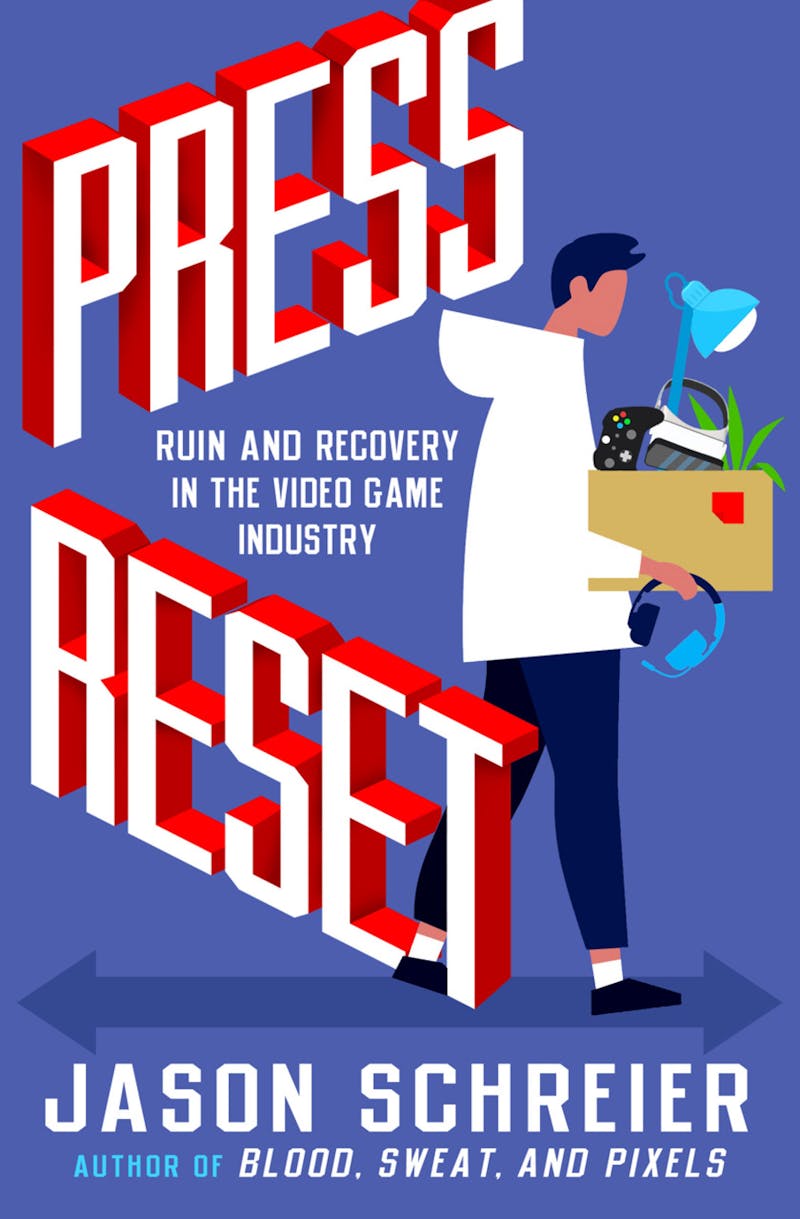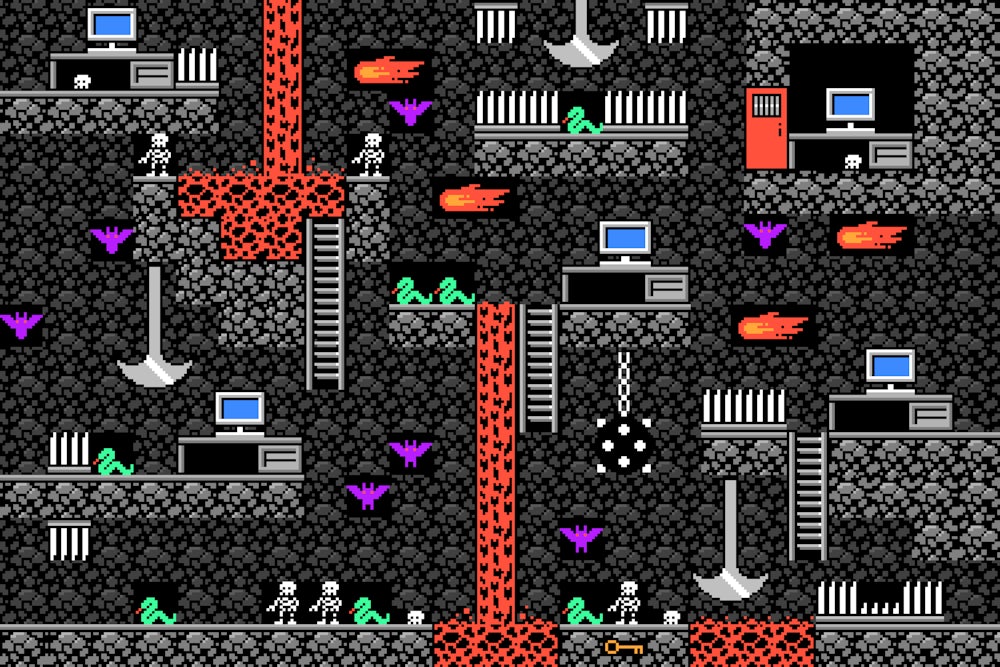In 2006, a professional baseball player named Curt Schilling started a video game company. Schilling was probably most famous for a heroic pitching performance on an injured ankle in a 2004 playoff series for the Boston Red Sox. The team would go on to win the World Series that year, ending a decades-long championship drought, and cementing Schilling’s status as a hero throughout New England.

Schilling named his company 38 Studios, after his uniform number. He headquartered it in Massachusetts. His only experience in video games was as a fan of them, but he hired a lot of industry veterans and talented game developers. He wanted to make a kind of game called a “massively multiplayer online role-playing game.” All you need to know about MMORPGs, for the sake of this tale, is that they are very complex, and potentially very lucrative, because users don’t just spend money on the game once. They have to pay subscription fees, to play the game online, with other players, on computer servers controlled by the game’s publisher. One MMORPG, World of Warcraft, has made billions for its parent company since it launched in 2004.
Schilling’s dream was to make a game as popular and profitable as World of Warcraft. He hired the popular fantasy author R.A. Salvatore to create the backstory and “lore” of his game’s fictional world, and comics artist Todd McFarlane to create its visual identity. He continued bringing on video game artists, developers, and designers, paying them well and spoiling them with perks, like free meals and personalized laptops. He was, after all, trying to lure top talent from more established video game studios.
To start with, Schilling was paying for most of this himself. But he soon found a lifeline, in the form of America’s incoherent, cronyist approach to industrial policy. Schilling met Donald Carcieri, the Republican governor of Rhode Island, and a plan was concocted: The Rhode Island Economic Development Corporation would give Schilling a large loan guarantee if he moved his company to the state. Carcieri would get the residual star appeal of association with a baseball hero, and a promise of 450 new jobs in Rhode Island. Schilling would get $75 million, guaranteed by the state. So Schilling moved his team to Providence, Rhode Island, a charming city, but not exactly the home of the games industry. (Though, as we’ll see, there is no true home of the video game industry.) He promised that the company would take on the mortgage payments of anyone having trouble selling their Massachusetts homes (the loan, and the move, happened over 2010 and 2011, in the aftermath of the housing crash and Great Recession).
In 2011, 38 Studios was burning through about $4 million a month; by early 2012, the company ran out of cash. It quietly stopped paying most of its outside vendors or hiring new employees to work on Schilling’s dream game, which was probably still more than a year away from completion. It missed a loan repayment, leading the new governor of Rhode Island, Lincoln Chafee, to reveal to the public just how dire the company’s financial situation was. The story of Rhode Island’s loan to Curt Schilling’s video game company became a local scandal and a national joke. In May, the company abruptly laid off the entire staff, who were “left stranded in Rhode Island, where there were no other video game companies or jobs.”
An entire book could be written about the saga of 38 Studios. In Press Reset, the video game industry journalist Jason Schreier covers it in a few dozen pages. Each chapter of the book covers the closure of a different game studio. In an industry worth $150 billion, mass layoffs and untenable working conditions are surprisingly common, though rarely examined. Most of the video game press is aimed at either the consumer or the investor, and most outlets concern themselves with how a game plays, or how much it sold. Instead, by looking at the labor of video games, Schreier sets out to answer one of the industry’s weirdest mysteries: Why is making video games, something an entire industry of highly paid, intelligent people has been doing for decades, so difficult?
While reporting on video games for the news site Kotaku, where he started in 2012 (he now works for Bloomberg), Schreier developed a unique beat: He became, most likely, the industry’s first labor reporter. At Kotaku, Schreier started soliciting stories from people who made the games, often after reports of layoffs or studio closures. He began reporting on the creation of complex, big-budget games from the perspectives of the people responsible for developing the code, designing the levels, or testing nearly complete games for bugs. These stories—perhaps unexpectedly—were popular with Kotaku’s audience of video game enthusiasts. Many gamers, who might once have blamed “lazy devs” for a game’s flaws or shortcomings, are now more likely to direct their ire toward greedy executives or exploitative managers.
Schreier has been successful enough that Press Reset is his second book about the tribulations and treatment of the people who make video games. His prior book, Blood, Sweat, and Pixels, was a developer’s-eye-view of the making of a handful of popular games, ranging from Stardew Valley, a solo developer’s years-long labor of love, to high-profile, big-ticket games with incredibly messy production histories, like a Star Wars game that Disney canceled after years of tortuous development. As one reviewer noted, fiascoes are always more interesting than successes, which could explain Schreier’s decision to build this book around stories of companies and game studios failing.
Dysfunction is baked into the video game production process, as it currently exists. The big-budget games industry is dominated by a few large companies, the publishers. Like book publishers, they are responsible for distributing and marketing games (much but not all of this is entirely digital now, but most of the publishers established themselves when game distribution meant getting physical discs and cartridges on retail store shelves). Games are actually made by studios, which are generally either owned directly by the publishers or independent. Making big-budget video games takes an enormous amount of highly specialized labor. It is possible for one person to make a game, and even for that game to be a hit, but the biggest, most profitable games released each year are nearly always made by enormous teams of people, working directly or indirectly for those publishers.
Because these games are so complex, they are often quite unfinished or bug-ridden very close to their scheduled release dates. Video games are constantly delayed, but they cannot be delayed forever, especially if a large corporation’s earnings report depends on selling a lot of a heavily marketed video game. So many studios enter a period of grueling overwork and mandatory overtime. The practice is so common in the industry that it is simply known as “crunch.” A few years ago, one major studio founder actually bragged about enduring 100-hour workweeks in the period leading up to a major new game’s release. Reporting from Schreier and others calling attention to the exploitative nature of “crunch” led many studios to announce new policies banning the practice, but they are self-policing, and crunch in some cases simply may be outsourced to smaller studios, often overseas, away from the prying eyes of American reporters.
After the game is released comes the other problem: Now there is a studio full of expensive video game developers who are no longer developing a video game. (This is one reason why so many publishers develop franchises with annual or semiannual releases, like professional sports titles or war games with dependably high-selling new installments released almost every year.) This can lead to mass layoffs, and, as documented in Press Reset, studio closures, which can afflict even studios that release commercially and artistically successful games.
Irrational Games, creator of BioShock, one of the most critically acclaimed video games in history, was shuttered shortly after the release of a well-reviewed and bestselling sequel, BioShock Infinite, when the studio’s co-founder Ken Levine decided to move on to other projects. Irrational’s parent company determined it couldn’t afford to lose Levine, but the people who actually made his popular games were disposable. In another case, Big Huge Games, a studio Schilling purchased that actually managed to release a game, nonetheless closed along with 38 Studios. Then the publisher Epic Games rescued about a third of its employees to form a new studio—only to close that studio a few months later, meaning the same people experienced mass layoffs twice in less than a year.
These layoffs completely upend the lives of video game workers. Employees of 38 Studios, like Jennifer Mills, a texture artist (as Schreier explains, that “meant that her job was to paint 3-D models and environments”), uprooted their lives to go to work for Schilling based on his grandiose promises, eventually found themselves working without pay, and received no severance when the studio shuttered. Workers like Thom Ang, an art director, found themselves stuck with mortgages on the Massachusetts houses for which 38 Studios had promised to take responsibility when the company moved. Two of the employees “each faced a net loss of over a hundred thousand dollars.”
Even though video game workers are highly skilled, finding the next job is far from straightforward. Video game studios are located in cities around the world, with the North American segment of the industry in particular having no clear-cut industry town. The globalized, geographically scattered nature of the games business means it resists metonymy, which not even Silicon Valley can boast. Many workers are forced to uproot their lives each time they change jobs. After being laid off in Providence, Jennifer Mills “moved back to Boston (where she was laid off), then to Texas (where she was laid off), and then to Seattle,” where, Schreier reports, she found some stability, but still felt “looming doom.”
The chaotic and exploitative employment arrangements of the video game industry might be justified or excused by pointing to the industry’s inarguable success—after all, those arrangements produced all-time classics like BioShock and reliable regular hits like the Call of Duty franchise. But gamers might come away from Press Reset with some new (or at least more refined) explanations for the things they don’t like about the industry. Endemic instability could help explain why hugely anticipated games so frequently get delayed and are then released seemingly unfinished, or why well-respected veteran developers like Warren Spector so often fail to find professional, stable homes or secure funding for new projects. Developers’ lack of autonomy at big studios might also help explain how a studio like Mythic Entertainment went from making competent online multiplayer PC games to a widely detested free-to-play mobile game. (One chapter tells of “product managers” from Mythic’s parent company, Electronic Arts, forcing developers to implement features that they knew made the game worse, in order to entice players to pay to make the game actually fun. “People are going to hate this,” an employee recalls his teammates saying. People did. Mythic closed.)
Video game workers are not treated poorly because it’s so hard to make a game. The causation might actually run in the other direction: It might be hard to make a video game because the people who make them are treated so poorly.
In discussions of video game industry labor issues, one useful fact is sometimes overlooked: We already have a model for producing big-budget entertainment products that require a lot of highly skilled technical labor, and an industry that specializes in manufacturing discrete works of collaborative popular art under temporary work arrangements. It mostly manages to do so without anywhere near the same problems of overwork and routine professional volatility that plague the gaming industry. It’s called Hollywood filmmaking.
When a new Hollywood film enters production, a new corporation is formed to employ everyone who will work on it. That company halts operations when the film is complete. The process is disruptive, like much creative work, but hardly as disruptive as the studio closures Schreier documents in his book, because no one expects that the corporation formed for the purpose of creating a single movie will exist any longer than the time it takes to produce that movie. While everyone involved in that film’s production receives a salary from the corporation, no one’s career and benefits depend on it existing in perpetuity. When the film wraps, the company that employs all its writers, actors, and skilled tradespeople lets them go, but it is not a life-upending moment for any of them in the way it was when the game studio that produced BioShock Infinite closed, shortly after that game’s completion. Most creative and technical workers involved in making the movie retain their health insurance, and continued access to a pension. The actors and writers even have a promise of future payment for their work on the movie in the form of residuals.
The stagehands, makeup artists, camera operators, and other so-called below-the-line workers who helped produce the film now need to seek a follow-up gig, but—like union construction workers—they can do so secure in the knowledge that their next job will adhere to the same rules regulating the scope and duration of their labor that their last one did. They will not need to negotiate the conditions of their work with a new employer; the entire industry has agreements with the relevant unions.
That fact is the central difference between the two fields. Film and television production is one of the most densely unionized industries left in the United States. The guilds—the Screen Actors Guild (SAG), the Writers Guild of America (WGA), and the Directors Guild of America (DGA)—along with the unions of technical workers and tradespeople—primarily the International Alliance of Theatrical Stage Employees (IATSE)—have collective bargaining agreements with the Alliance of Motion Picture and Television Producers, a trade association that represents not just one company but the entire mainstream film and television production business. Hundreds of films and television shows produced every year in the United States are created by writers, actors, and technicians working under these agreements.
All of these laborers are independent, but they have been collectively bargaining to set workplace rules since the 1920s. In the days of the studio system, most of those workers would have been directly and continuously employed by one of the major studios, but since the 1950s they have been effectively freelancers. The major studios finance and distribute films now; independent producers do the work of hiring people to make them. While there are obvious technical differences between creating a film and creating a video game, it doesn’t really matter that writing a script is different from crafting a level, when you are looking at how to organize labor: It’s all just creative work-for-hire.
One important fact about heavily unionized Hollywood is that the system works. Not in the sense that the product is creatively or aesthetically good, but in that these incredibly complex products are mostly completed in time to meet their scheduled release dates, and everyone in the industry knows in advance roughly how much time and money and labor will be required for that to be the case. In video games, as reported in Press Reset, no one seems to know—or be willing to admit—how many people and hours of work will be required to honor promises made about the quality and scope of big-budget games. In Hollywood, as the law professor and labor law expert Catherine Fisk puts it, “Independent, entrepreneurial, short-term workers have bargained collectively for eighty years to the significant benefit of themselves and the industry in which they work.”
This is crucial: Organized labor didn’t just help the collective laborers of Hollywood; it helped the industry itself figure out how to make movies efficiently. In their comprehensive analysis of the American film industry, The Classical Hollywood Cinema, film theoretician Janet Staiger, along with co-authors David Bordwell and Kristin Thompson, argue, “What traditional historians have tended to ignore is that labor-force activities and financing reinforced rather than contradicted or changed the production system” of movies after the death of the studio system. They found that “one of the effects of union activities and State intervention was the reinforcement and solidification of the division of labor,” as union jurisdictional battles, especially at IATSE, “resulted in very distinctly drawn job boundaries.” With clearly defined responsibilities, IATSE members could refine their professional skills to keep pace with technological change. (Schreier notes that yet another hitch to reporting on—or working in—the video game industry is that job titles are essentially meaningless, or at least mean wildly different things depending on what studio you work for.) As the filmmaking business evolved, “craft specialization continued to increase,” and the trade unions functioned “as the means of easing the introduction of new equipment.” In other words, the fact that the entire industry was organized didn’t hold it back as the medium evolved; it allowed the industry to continue being able to make films as old modes of production became obsolete and new technologies emerged.
In this light, the solution seems simple: Organize the video games industry. If there were a video game developer’s union as powerful as the Writers Guild, with agreements with all the major publishers, game development would be a vastly different career, and many of those problems seemingly endemic to game production might suddenly seem less intractable.
Of course, Schreier has thought of that. His last chapter, on how to fix the industry, mentions the people currently trying to organize its workers, like Emma Kinema, co-founder of the labor group Game Workers Unite. Last year, the Communications Workers of America hired Kinema to try to organize the industry. There is grassroots interest in unionizing, even if there is also widespread apprehension and skepticism.
Unfortunately, the skepticism might be warranted. At this moment, it is hard to envision a video game worker guild amassing the power and influence of the Hollywood guilds. If Hollywood had come into existence as an economic and cultural force at any other time in American history, it’s difficult to imagine writers, actors, and technical workers having the power and solidarity necessary to become such dominant players in it. As the historian Michael Denning argues in The Cultural Front, the growth of the guilds and successful collective bargaining agreements with the studios came about in the context of “the laboring of American culture”—it was an era in which a mass, nationwide left-wing anti-fascist political movement coincided with the industrialization of certain “creative” industries and the emergence of a new “plebeian” generation of artists. While IATSE dates back to nineteenth-century theater, the creative guilds (SAG and the WGA) were organized, and won power, during a period of mass unionization, spurred by new intellectual energy around organizing professionals, and changes to the law that made such organizing possible. “It was the prairie fire of union organizing sparked by Roosevelt’s National Industrial Recovery Act of 1933, with its declaration of labor’s right to representatives of its own choosing,” Denning writes, “that rekindled culture industry unionism.” SAG formed in 1933, and the Screen Writers Guild won a National Labor Relations Board election in 1938.
Nostalgia for that era is understandable but probably unhelpful. The power of the Hollywood guilds shows us a past worth remembering, but difficult to reproduce. Even in heavily unionized Hollywood, there are ominous trends: While IATSE is an international union, major studio productions now routinely escape high labor costs in Hollywood (and the strong U.S. dollar) by filming abroad. And the movie industry hasn’t avoided the problems of the game industry entirely. Because the period in which computer graphics developed into an essential component of filmmaking happened well after the era of labor radicalism described by Denning, Hollywood special-effects studios never developed a strong union. (They formed a professional trade association instead.)
And now, special-effects houses are treated remarkably like video game studios, expected to perform their highly technical and complex work on difficult deadlines. The results are not quite so disastrous as in video games, but the absence of the sort of workplace regulation that, for example, makeup and costuming artist-workers enjoy, thanks to their union, is becoming apparent in big-budget films the same way it is in games. Tom Hooper’s cinematic adaptation of the stage musical Cats came out in 2019. It was a critical and financial bomb, in large part because of the grotesque design of the partly computer-animated cat-actor hybrids, and the fact that the film was released with glitchy and incomplete computer effects. In that respect, Cats feels like an early vision of a world in which Hollywood business practices come to resemble video game ones, instead of the other way around: incomplete versions of movies, released with glaring technical flaws resulting from the poor management of nonunion workplaces. It was perhaps the first tentpole film that would have benefited from a day-one patch.
As measured in polling, Americans feel more favorably toward labor unions now than they have in years. Considering how few Americans belong to one, the problem remains of translating that generic support into public pressure. The stories in Press Reset suggest one argument: Labor advocates could harness the incredible online energy of angry gamers by arguing that a new era of mass organization wouldn’t just be good for the people who make video games, it’d be good for the games themselves.
But while Schreier and other chroniclers of video game business practices look for ways to fix the industry, it’s important to remember that, from the perspective of the people in charge of it, nothing about it is broken. Games generate over $150 billion in revenue per year. If that isn’t enough money to make game development a humane and stable career, it isn’t a result of poor organizational practices—it’s a reflection of power.
One small irony in the book is that Curt Schilling, one of the book’s parade of disastrous executives, may have known little about the video game industry, but he knew well the importance of strong organized labor: He was a member of the Major League Baseball Players Association, and it was thanks to contracts negotiated by that union that he made enough money playing baseball to start his dream company. It was also that experience that led him to spend so much on luring “stars” to his company. In fact, when he founded 38 Studios, Schilling intended to have its employees share very directly in the wealth he imagined it would bring him, with a proposed 50-50 profit share. An industry veteran brought in as the company’s first CEO forced Schilling to scrap the idea, because, the CEO said, “investors’ heads would explode” if they couldn’t take that profit themselves.
Schilling, a fan of games, was under the mistaken impression that the people who actually made them deserved to share in the often lucrative rewards of doing so. This was, in the video game industry, as in most industries, a notion he had to be disabused of. As the CEO explained (in a “case study” about 38 Studios for Harvard Business School), Schilling “really needed Company 101.” For video game workers to improve their lot, they will have to force industrywide adoption of a new curriculum.








